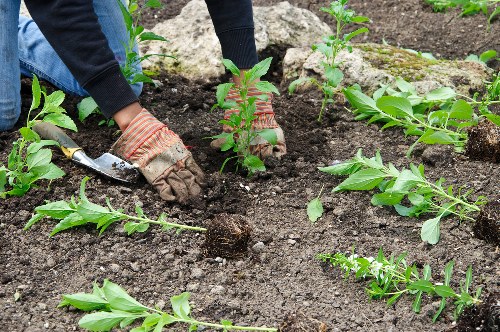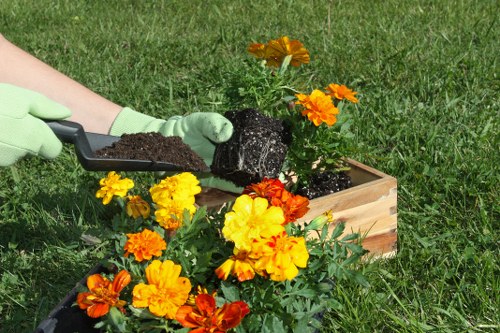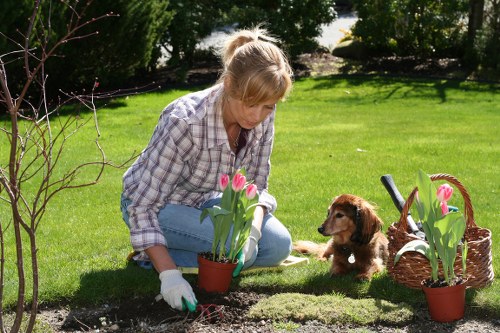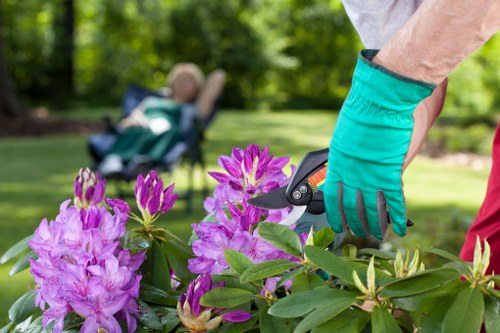Tree Cutting Service in Landscape Gardeners

Tree cutting services play a pivotal role in maintaining the health and aesthetics of your landscape garden. Whether you're looking to enhance the visual appeal, ensure safety, or promote healthy growth, professional landscape gardeners offer a range of tree cutting solutions tailored to your needs. Understanding the nuances of tree cutting can help you make informed decisions and achieve the best results for your outdoor space.
Tree cutting, also known as tree pruning or trimming, involves the selective removal of branches and stems to improve the tree's structure, remove dead or diseased limbs, and encourage healthy growth. This essential maintenance practice not only enhances the beauty of your garden but also ensures the safety of your property by preventing potential hazards like falling branches.
When it comes to landscape gardening, the expertise of professional tree cutters is invaluable. These specialists possess the knowledge and tools required to handle various tree species, each with its unique characteristics and needs. By entrusting your tree cutting needs to experienced landscape gardeners, you can ensure that your trees remain healthy, vibrant, and well-integrated into your overall garden design.

Benefits of Professional Tree Cutting Services
Engaging professional tree cutting services offers numerous advantages that go beyond mere aesthetic improvements. Here are some key benefits:
- Enhanced Safety: Regular tree cutting helps identify and remove hazardous branches, reducing the risk of accidents caused by falling limbs.
- Improved Tree Health: Proper pruning removes diseased or damaged parts of the tree, preventing the spread of infections and promoting overall health.
- Increased Sunlight and Airflow: Thinning out dense branches allows more sunlight and air to penetrate the canopy, benefiting both the tree and the surrounding plants.
- Enhanced Aesthetics: Well-maintained trees contribute to a more attractive and harmonious garden, enhancing the overall landscape design.
- Promotes Growth: Strategic pruning encourages the growth of new branches and flowers, leading to a fuller and more vibrant tree.

Types of Tree Cutting Techniques
1. Crown Thinning
Crown thinning involves the selective removal of branches to reduce the density of the tree's canopy. This technique improves light penetration and airflow, which can help prevent diseases and promote healthy growth.
Advantages:
- Reduces the risk of branch breakage.
- Enhances the natural shape of the tree.
- Improves the overall health of the tree.
2. Crown Raising
Crown raising focuses on elevating the tree's canopy by removing lower branches. This is particularly beneficial in areas where low branches obstruct pathways, buildings, or utilities.
Benefits:
- Provides clearance for walkways and structures.
- Enhances visibility and accessibility.
- Improves the structural integrity of the tree.
3. Crown Reduction
Crown reduction is the process of decreasing the size of a tree's canopy by cutting back branches to a lateral branch or bud. This technique helps control the tree's size while maintaining its natural shape.
- Prevents the tree from becoming too large.
- Maintains the tree's structural balance.
- Encourages new growth in desired areas.

Choosing the Right Tree Cutting Service
Selecting a reliable tree cutting service is crucial for achieving the desired outcomes and ensuring the safety of your property. Consider the following factors when choosing a landscape gardener for tree cutting:
- Experience and Expertise: Look for professionals with extensive experience in tree cutting and a deep understanding of various tree species and their specific needs.
- Licensing and Insurance: Ensure the service provider is licensed and adequately insured to protect against potential damages or accidents.
- Reputation: Read reviews and testimonials to gauge the quality of service and customer satisfaction.
- Safety Practices: Verify that the team adheres to strict safety protocols and uses the right equipment for tree cutting.
- Comprehensive Services: Choose a service that offers a range of tree cutting solutions, from pruning and trimming to removal and emergency services.

Tree Cutting Process: What to Expect
1. Initial Assessment
Professional tree cutters begin with a thorough assessment of your trees and the surrounding landscape. This involves evaluating the tree's health, structure, and any potential hazards. During this phase, the landscaper will discuss your goals and objectives to tailor the tree cutting plan accordingly.
Key Considerations:
- Tree species and age.
- Extent of overgrowth or damage.
- Environmental factors such as wind exposure and sunlight.
2. Planning and Preparation
Once the assessment is complete, the tree cutting team formulates a strategic plan outlining the specific cuts and techniques to be used. This planning ensures minimal impact on the tree's health and the surrounding environment.
Preparation Steps:
- Gathering the necessary tools and equipment.
- Setting up safety barriers if needed.
- Informing the homeowner about the process and any precautions.
3. Execution
The actual tree cutting begins with careful pruning, trimming, or removal of branches as per the plan. The professionals ensure that each cut promotes the tree's health and enhances its appearance. Advanced equipment and techniques are employed to handle even the most challenging tasks safely and efficiently.

Post-Cutting Care and Maintenance
After the tree cutting process, proper care is essential to maintain the tree's health and ensure the longevity of the cutting work. This includes:
- Cleaning Up: Removing all debris, including cut branches and leaves, to keep the area tidy and prevent potential hazards.
- Monitoring Tree Health: Regularly checking the tree for signs of stress or disease, especially after significant pruning.
- Follow-Up Services: Scheduling periodic maintenance visits to address any new growth or additional pruning needs.
By investing in post-cutting care, you can ensure that your trees remain robust, healthy, and a beautiful part of your landscape for years to come.
Additional Maintenance Tips
- Water your trees adequately, especially during dry seasons.
- Apply appropriate fertilizers to support growth.
- Inspect for pests and treat infestations promptly.

Environmental Considerations
Tree cutting not only impacts the health of individual trees but also affects the broader ecosystem of your garden. Conscious tree cutting practices contribute to environmental sustainability by:
- Promoting Biodiversity: Maintaining a variety of tree species supports diverse wildlife habitats.
- Reducing Carbon Footprint: Healthy trees sequester carbon dioxide, helping to mitigate climate change.
- Preventing Soil Erosion: Properly maintained trees stabilize the soil, reducing the risk of erosion.
Landscape gardeners prioritize eco-friendly tree cutting methods, ensuring that their practices align with environmental conservation goals. This includes using sustainable tools, minimizing waste, and preserving the natural balance of your garden.
Sustainable Practices in Tree Cutting
Adopting sustainable practices in tree cutting can lead to long-term benefits for both your garden and the environment:
- Utilizing energy-efficient equipment to reduce emissions.
- Recycling green waste into mulch or compost.
- Implementing integrated pest management to minimize chemical use.
Community Impact:
Responsible tree cutting contributes to the overall health of the local ecosystem, supporting community green spaces and enhancing urban forestry.

Common Mistakes to Avoid in Tree Cutting
Even with professional services, being aware of common tree cutting mistakes can help you maintain the best practices:
1. Over-Pruning
Removing too many branches can stress the tree, inhibit growth, and make it more susceptible to diseases. It's essential to follow recommended pruning standards for each tree species.
Solution:
Consult with experienced landscape gardeners to determine the appropriate amount of pruning needed for your trees.
2. Using Improper Techniques
Incorrect cutting methods can cause damage to the tree, leading to decay or structural weaknesses. For example, improper topping can lead to weak branch growth and increased vulnerability to storms.
Solution:
Ensure tree cutting is performed by trained professionals who use correct techniques and tools.
3. Ignoring Safety Protocols
Tree cutting can be hazardous if safety measures are not strictly followed. Risks include falling branches, equipment accidents, and injuries.
- Always wear appropriate protective gear.
- Secure the work area to prevent unauthorized access.
- Use the right tools and maintain them properly.
4. Neglecting Aftercare
Post-cutting care is crucial for the recovery and health of the tree. Neglecting this can lead to poor growth and increased susceptibility to pests.
Solution:
Follow up with regular maintenance and care as recommended by your landscape gardener.

Cost Factors in Tree Cutting Services
The cost of tree cutting services can vary based on several factors. Understanding these elements can help you budget effectively:
- Tree Size: Larger trees require more time and specialized equipment, increasing the overall cost.
- Complexity: Trees with intricate branching patterns or those located near buildings and power lines demand more careful handling.
- Accessibility: Difficult-to-reach trees, such as those on steep slopes or tight spaces, may incur higher charges.
- Health of the Tree: Diseased or damaged trees might require additional treatments, influencing the cost.
- Removal Services: If removal is necessary, the disposal of the tree and debris adds to the expense.
Getting Accurate Estimates
To obtain a precise cost estimate, request a detailed assessment from your chosen tree cutting service. This should include an evaluation of the factors mentioned above and a transparent breakdown of all potential charges.
Tips for Cost Management:
- Schedule regular maintenance to prevent the need for extensive cutting.
- Combine tree cutting with other landscape services for potential discounts.
- Maintain clear communication with your service provider about your budget and expectations.

Choosing the Right Time for Tree Cutting
Timing plays a significant role in the effectiveness and safety of tree cutting. The best time to prune or cut trees depends on several factors, including the tree species, climate, and specific goals.
Optimal Seasons
- Late Winter to Early Spring: This is ideal for most trees as they are still dormant, reducing stress and promoting vigorous growth in the spring.
- Summer: Some light pruning can be done in summer, especially for removing dead or diseased branches. However, excessive cutting should be avoided to prevent heat stress.
- Autumn: While not the best time for heavy pruning, selective cutting can be performed to prepare trees for winter.
Tree-Specific Considerations:
Certain tree species may have specific pruning requirements. For example, flowering trees are best pruned immediately after they bloom to avoid removing buds for the next season.
Avoiding the Wrong Time
- During Active Growth: Pruning during the peak growing season can stress the tree and hinder its development.
- Before Frost: Cutting trees just before frost can make the wounds more susceptible to cold damage.
Consulting Professionals:
Professional landscape gardeners can advise you on the optimal timing based on your specific trees and local climate conditions.

Tools and Equipment Used in Tree Cutting
Modern tree cutting services utilize a variety of tools and equipment to perform tasks efficiently and safely. Some of the essential tools include:
- Pruning Saws: Used for cutting smaller branches with precision.
- Chainsaws: Essential for larger branches and trunk cutting, offering power and efficiency.
- Hedge Trimmers: Ideal for trimming and shaping tree branches and shrubs.
- Loppers: Handheld tools for cutting thick branches that are too large for pruning shears.
- Climbing Gear: Harnesses, ropes, and other equipment for safely accessing higher branches.
Safety Equipment:
- Protective Gloves: To prevent injuries and enhance grip.
- Safety Glasses: Protect eyes from flying debris.
- Hard Hats: Shield the head from falling branches.
- Ear Protection: Reduce noise exposure from loud machinery.
Maintenance of Tools:
Proper maintenance of tree cutting tools ensures their longevity and effectiveness. Regular sharpening, cleaning, and inspections are vital to keep equipment in optimal condition.
Advanced Equipment:
For more complex tasks, landscape gardeners may use specialized machinery such as cranes, bucket trucks, and stump grinders to handle large-scale tree cutting and removal projects.

Environmental and Legal Considerations
Tree cutting is not only a matter of horticulture but also involves environmental and legal responsibilities. Navigating these aspects ensures that tree cutting is performed responsibly and in compliance with local regulations.
Environmental Impact
Responsible tree cutting practices take into account the broader environmental implications, such as:
- Habitat Preservation: Maintaining habitats for local wildlife by carefully selecting which trees and branches to cut.
- Sustainable Practices: Using eco-friendly methods and materials to minimize the ecological footprint.
- Carbon Sequestration: Preserving healthy trees that contribute to carbon dioxide absorption and climate regulation.
Legal Regulations:
Tree cutting may be subject to local laws and regulations, which can include obtaining permits, adhering to preservation guidelines, and respecting protected tree statuses. Failure to comply can result in fines and legal repercussions.
Obtaining Permits:
- Check with local municipalities regarding permit requirements for tree cutting.
- Provide necessary documentation and justification for the cutting project.
Protected Species:
Some tree species may be protected due to their ecological significance or rarity. It's essential to identify these trees and seek appropriate guidance before proceeding with any cutting.
Consulting Authorities:
Engage with local environmental agencies or tree councils to understand the guidelines and secure the necessary approvals for your tree cutting project.

Final Thoughts on Tree Cutting Services
Tree cutting is a critical aspect of landscape gardening that requires expertise, precision, and a deep understanding of tree biology and environmental considerations. By partnering with professional landscape gardeners, you can ensure that your tree cutting needs are met effectively, enhancing both the beauty and safety of your garden.
Key Takeaways:
- Professional tree cutting promotes tree health and garden aesthetics.
- Choosing the right service involves evaluating experience, reputation, and safety practices.
- Understanding different cutting techniques helps in making informed decisions.
- Environmental and legal considerations are paramount in responsible tree cutting.
Take Action Today!
Don't wait until your trees become a hazard or detract from your garden's beauty. Contact us today to schedule a consultation with our expert landscape gardeners and transform your outdoor space with our professional tree cutting services.
Book Your Service Now
Ready to enhance your landscape? Book your tree cutting service now and experience the difference professional care can make.